06/30/2012. This is believed to have been the world's first helicopter designed specifically for military use and was the first US rotary-wing aircraft to be mass-produced.
The R-4 was a refinement of Sikorsky's VS-300 design, with a faired, canvas-covered fuselage, side-by-side seating, and full dual controls. With a three-bladed main rotor and a tail boom supporting a smaller anti-torque rotor (on the left side), the R-4 set the design for future Sikorsky helicopters. The main landing gear was on outriggers with a small tail wheel, although many were fitted with twin pontoons for landing aboard ship or on water.
The USAAF ordered the prototype XR-4 in 1941 (s/n 41-18874, c/n 2), and powered by an 165 hp Warner R-500-3 engine it was first flown on January 13, 1942. The XR-4 order was followed by an order for thirty evaluation R-4s (fitted with 180 hp Warner R-550-1 engines), three YR-4As (s/n 42-107234 to
42-107236) and 27 similar YR-4Bs (s/n 42-107237 to 42-107248, 43-28223 to 43-28235, 43-28247, 43-47953). Final R-4 order was for 100 production R-4Bs (s/n 43-46500 to 43-46599). In 1943 the XR-4 was re-engined with the Warner R-550-1 and redesignated XR-4C.
The USAAF flew tests with the XR-4 from a platform on the tanker Bunker Hill on May 6-7, 1943, and with the YR-4 from the Army transport James Parkeron July 6-7, 1943. Subsequently, more rigorous trials were conducted at sea aboard the British merchant ship Daghestan and the USGC cutter Cobb (WPG-181), during which the two R-4s took part in a trans-Atlantic crossing.
Seven of the YR-4Bs were transferred to the RAF (the first on July 2, 1943) and designated Hoverfly I they became the first helicopters operated by the British armed forces, while three were transferred to the USCG. Of the 100
R-4Bs, 45 went to Britain for service with the RAF and RN, and 22 went to the USCG. In 1946-1947, 21 of the surviving USCG YR-4B/R-4Bs were transferred to the USN, being designated HNS-1.
The USAAF used a limited number R-4s operationally during WW II, mostly for rescue in Alaska, Burma, and other difficult-terrain areas. The above pictured aircraft was transferred to Birma were it was assembled (site files) on January 23, 1945, unfortunately it crashed after six months, on July 26.
